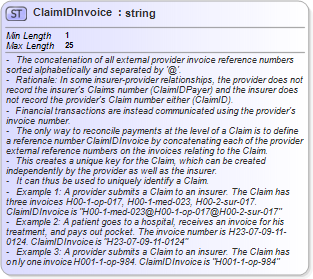<xs:simpleType name="ClaimIDInvoice">
<xs:annotation>
<xs:documentation>
- The concatenation of all external provider invoice reference numbers sorted alphabetically and separated by '@'.
- Rationale: In some insurer-provider relationships, the provider does not record the insurer's Claims number (ClaimIDPayer) and the insurer does not record the provider's Claim number either (ClaimID).
- Financial transactions are instead communicated using the provider's invoice number.
- The only way to reconcile payments at the level of a Claim is to define a reference number ClaimIDInvoice by concatenating each of the provider external reference numbers on the invoices relating to the Claim.
- This creates a unique key for the Claim, which can be created independently by the provider as well as the insurer.
- It can thus be used to uniquely identify a Claim.
- Example 1: A provider submits a Claim to an insurer. The Claim has three invoices H00-1-op-017, H00-1-med-023, H00-2-sur-017. ClaimIDInvoice is "H00-1-med-023@H00-1-op-017@H00-2-sur-017"
- Example 2: A patient goes to a hospital, receives an invoice for his treatment, and pays out pocket. The invoice number is H23-07-09-11-0124. ClaimIDInvoice is "H23-07-09-11-0124"
- Example 3: A provider submits a Claim to an insurer. The Claim has only one invoice H001-1-op-984. ClaimIDInvoice is "H001-1-op-984"
</xs:documentation>
</xs:annotation>
<xs:restriction base="xs:string">
<xs:minLength value="1" />
<xs:maxLength value="25" />
</xs:restriction>
</xs:simpleType>
|

